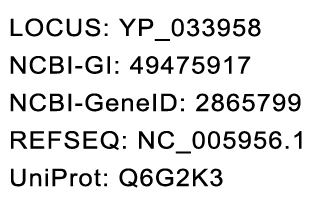 | ||
Bartonella henselae hypothetical protein 11960 (BH11960) is encoded by the BH11960 gene. This hypothetical protein is conserved in all Bartonella species whose genomes have been sequenced to date and are highlighted in the picture below.
Contents
Properties
“Hypothetical protein BH11960 (Bartonella henselaei str. Houston-1”. [1].
Function
The function of the BH11960 protein is not known. However, it is hypothesized that its function is involved in signal transduction that regulates aerotolerance in conjunction with the other genes within its cluster. Evidence for such function is as follows:
Protein Sequence
The importance of this protein lies in the beginning of the sequence and is represented in the conceptual translation below. This region contains the aerotolerance motif, the transmembrane hydrophobic segment highlighted in yellow, and a high conservation region represented in all studied orthologs. Furthermore, a signal peptide protein is present in this region which allows transport of a protein.
Based on sequence analysis performed by PSortB program, this protein is located in the cytoplasmic membrane of this gram-negative bacteria and contains a double transmembrane domain.
Gene neighborhood
The four gene cluster of BH11940, BH11950, BH11960, and BH11970 are all proteins of unknown function transcribed on the sense strand and encoded by the same promoter. The promoter is ubiquitously conserved in the other Bartonella species and contains a TATA box. BH11960 is the largest of the four proteins.
Bartonella henselae: BH11960”. KEGG Database. [2].
